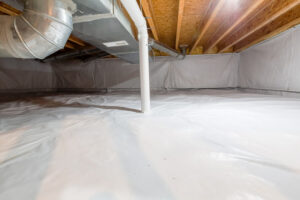Simple Crawl Space Hack Cut Cooling Costs
How Does Crawl Space Improvement Reduce Cooling Cost?

Anyone who has walked from his or her front door to a car in August in Texas knows just how humid Texas can get. If your home is built on a pier-and-beam foundation, you may think your crawl space is a cool spot. At least the raccoons think so, right?
Even though that dark and damp crawl space may be cooler than the sunlit exterior, it isn’t really that cool. That's because a damp unsealed crawl space invites humidity into your home. Not only can the humidity damage your home; it can also drive up your electricity bill. If you have HVAC ductwork under your home, that humidity is making your system run longer. That's because higher humidity makes your home warmer. So, you crank down the AC lower to feel cooler.
You have a couple of options for improving your crawl space: a vapor barrier and encapsulation. Both reduce humidity, but more protection will cost you more money. You can hire contractors to install these solutions. Or you can buy DIY kits if you feel like crawling under your house.
Crawl Space Vapor Barrier
When installing a vapor barrier, contractors install a thin plastic sheeting across the ground. It runs to the perimeter of your home, and contractors work around columns. Therefore, the whole ground under your home is covered by a combination of sheeting and foundation piers. The vapor barrier slows moisture transfer between the soil and the underside of your home. And it reduces mold problems which can cause breathing issues in humans and pets. According to HomeGuide, vapor barriers cost between $2 and $4 per square foot on average.
Crawl Space Encapsulation
Encapsulating your crawl space is a bit more expensive, with the average price being $3 to $7 per square foot. With this method of protecting your crawl space, contractors use thicker sheeting and also install a dehumidifier and sump pump. This solution completely blocks soil humidity from reaching the underside of the home. It is better protection at a higher price.
Encapsulation also improves a home’s insulation. HomeGuide states residential customers can experience a 20 percent reduction in energy bills. With thinner sheeting and no additional appliances, vapor barriers provide less savings. Plus, encapsulation seals home leaks that vapor barriers don’t address at all.
Best Energy Plans
Don’t get all hot and bothered by Texas humidity. Whether you pursue encapsulation, vapor barrier, or neither, you need a good electricity plan for your home. So shop for plans at https://www.texaselectricityratings.com to find a plan that best meets your home power consumption needs.
Comments
Post a Comment